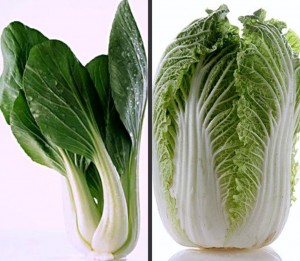 Chinese Cabbage (Brassica rapa subspecies), also known as snow cabbage is a green, leafy vegetable often used in Chinese cuisine. The vegetable is related to the Western cabbage, and is of the same species as the common turnip. Chinese cabbage is believed to have originated in China. Later, it was likely introduced to other countries throughout the region and then spread around the world. Today, Chinese cabbage is available in many countries but tends to be most popular in Asia.
Chinese Cabbage (Brassica rapa subspecies), also known as snow cabbage is a green, leafy vegetable often used in Chinese cuisine. The vegetable is related to the Western cabbage, and is of the same species as the common turnip. Chinese cabbage is believed to have originated in China. Later, it was likely introduced to other countries throughout the region and then spread around the world. Today, Chinese cabbage is available in many countries but tends to be most popular in Asia.
In the Philippines, it is popularly known as Pechay or Petsay. It was one of most often used vegetable in many Filipino dishes. Petsay is added to Filipino stews such as nilagang baka (boiled beef) or bulalo (boiled beef shank). People who choose to eat it raw can enjoy it tossed in a salad mixed with other greens.
Usually found in markets, when the vegetable is raw it can be identified by its elongated head and chalk-white stalks topped with deep green leaves. The stalks and leaves are generally different textures. The stalks of Chinese cabbage are much like celery, but are not stringy. The leaves are much more delicate. When cooking both parts together, it is usually suggested to allow the stalks to begin cooking first. When shopping for Chinese cabbage, visual inspection can provide a good idea of which plants are best. The colors should be vibrant. Varieties with white stalks should have bright and firm stalks. It is best if the leaves are not only green but also crisp and perky. Those with parts that are turning brown or that have slimy areas are not good choices. This vegetable is not usually considered seasonal in terms of availability. Most markets that offer Chinese cabbage sell it all year. It is not, however, a vegetable that is best purchased in bulk. It is generally best if eaten within a day or two of purchase.
Chinese cabbage is rich in Vitamin C, fiber, and folate. The color of the leaves suggest that it is rich in beta-carotene and calcium, especially in comparison to other types of cabbages that are less green. It is a vegetable that is generally low in fat but high in potassium.
How to grow Chinese Cabbage or Pechay
Climate & Growing Conditions
Gardening is best for this plant in cool temperatures. There are tropical varieties available also. Chinese cabbage will grow well with exposure to lots of sun, but it does tolerate partial shade. It needs shelter from wind and frost.
How to Prepare the Garden Soil
This vegetable will grow best in deep, well-drained soils mixed with plenty of compost. Avoid both light and heavy soils. The gardening soil pH range for Chinese cabbage should be from 6.5 to 7. (Instructions: testing your garden plot’s soil pH level.)
The key to gardening this plant is regular watering and fertilizing, to promote rapid growth. If the plant is allowed to grow too slowly, it will go to seed rather than produce the crop you desire. Chinese cabbage bolts (goes to seed) during dry hot weather.
Gardening Advice Tip:
- Mulch heavily to retain soil moisture and ward off bacterial rot.
- If you prefer to have tender white inner leaves, bind the heads (as you do with cauliflower) when the vegetable heads approach maturity.
How to Plant
Plan your garden planting of Chinese cabbage such that it reaches maturity before fall’s first frost arrives.
It is best to plant the seeds directly in the garden (Chinese cabbage doesn’t transplant well). Sow seeds 1/5 in deep and in clumps along the row with enough seed so that you can later thin the seedlings to 1′ apart. To make it easier to water the rows, allow 14″ of space between rows. Seedlings normally emerge within 2 weeks of planting.
How to Water
This vegetable needs a lot of water.
Gardening Advice Tip: Consider irrigating between the rows/beds to help keep water off the leaves (which helps prevent plant fungal problems).
How to Fertilize
Prepare the garden bed for Chinese Cabbage by digging in a complete fertilizer one week before planting. One month after planting, spread small amounts of the same fertilizer around the garden bed and water in immediately. When cabbages heads start to appear, give them an extra growing boost by applying a light dressing of urea.
Gardening Challenges
Chinese cabbage is prone to soil diseases such as club root and bacterial soft rot. Protect the crop by applying lime to your soil in the off season, and rotate this vegetable with unrelated crop several times over a few years.
You may also experience caterpillars or aphids on this vegetable in your garden.
Gardening Advice Tip: Practice good vegetable gardening by rotating your crops within your garden space with each new season. This will prevent many plant diseases.
How to Harvest
Chinese cabbage will usually grow to maturity in less than 4 months, and should be harvested in dry weather before the seed stalks appear (or the cabbage heads will split). Cut the heads just above the soil, when the heads feel solid.
Storage
Only freeze crisp and young cabbage. Wash and shred finely. Blanch for 1 ½ minutes. Chill in iced water for 2 minutes. Drain, and place in freezer bags, remove air, label and seal. Freeze for up to 6 months.
Sources: howtogardenadvice.com, Wikipedia.org; Photos: jennifermiller.net, aroramushroom.tradeindia.com